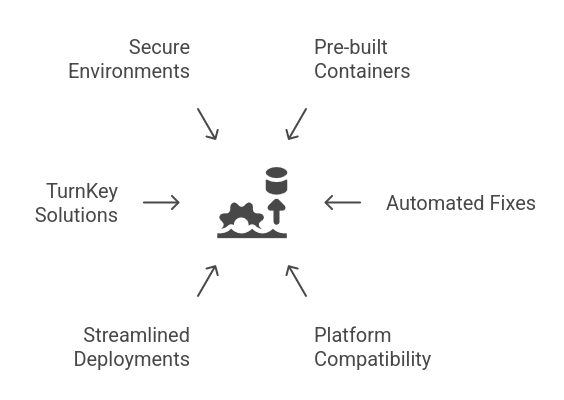Easily deploy and manage virtual appliances with TurnKey LXC Proxmox. Our LXC Support team is ready to assist you.
TurnKey LXC Proxmox
TurnKey LXC offers virtual appliances that are ready to use for a variety of applications by utilizing Linux Containers (LXC). Combining the advantages of virtual machines with chroot, LXC is an OS-level virtualization technique that operates several separate Linux environments on a single host. TurnKey LXC offers free, open-source, Debian-based appliances that are pre-configured and easy to deploy, easing container setup on platforms like Proxmox VE, conventional LXC, and sometimes LXD or OpenVZ.
What is LXC?
A Linux kernel feature called LXC establishes separate environments for services or apps to run in. Because it uses the host’s operating system rather than separate ones, it provides shorter startup times and greater performance than traditional virtual machines. LXC enables resource control, process isolation, and security technologies like SELinux and AppArmor, just like OpenVZ and FreeBSD jails. It is available on the majority of distributions as a component of the Linux kernel. It can be controlled by developers through command-line tools, the liblxc library, or Python, Go, and Ruby bindings.
Benefits of LXC
- Complete software stacks are included with pre-built containers, allowing you to easily launch programs like databases or web servers.
- Automated fixes and upgrades minimize manual labor while maintaining system security.
- For versatile use, it is compatible with a variety of platforms, including Proxmox VE and ordinary LXC.
- Speeds up and eases deployments by streamlining setup and configuration.
- Combines pre-made TurnKey solutions with lightweight LXC technology to provide effective performance.
- Provides your apps with environments that are dependable, safe, and isolated.

Downloading and Creating the TurnKey Core Container
The first step in configuring a TurnKey Core container in an LXC environment such as Proxmox is to download the TurnKey Core template from the platform’s templates section using the command line or interface. After that, construct the container by giving it a unique name, creating a strong root password, and allocating RAM, CPU cores, and disk space according to your requirements. Set up the network, usually with DHCP to assign IP addresses automatically.
If you intend to run Docker or nested virtualization within the container, finish the basic configuration by applying security updates, configuring passwords, and turning on nesting. After that, install any extra software you might need to run your apps and use apt instructions to update the system.
Understanding the difference between privileged and unprivileged containers is crucial since it has an impact on resource management and security. For comprehensive instructions and best practices, always consult the documentation of your virtualization platform, such as TurnKey Linux manuals and Proxmox or LXD.
Check out our expert article to learn more about Proxmox Helper Scripts and how they can simplify your Proxmox management.
Configuring Resources, Network, and Settings
Setting up resources, networks, and settings means making sure devices connect and work together safely and smoothly.Choosing how devices connect and collaborate safely and effectively is known as resource, network, and setting configuration. Setting IP addresses, network rules, security policies, and access controls are all part of this procedure to maintain secure and efficient communication.
First, determine what resources you require, such as servers or printers, and establish access controls. Users can access resources from a distance by setting up secure VPN connections. Monitoring resource utilization and performance is the essence of resource management.
Plan your network’s configuration next, taking into consideration the connections and kinds of devices. Assign IP addresses to enable communication between devices and select protocols that regulate data flow. To increase speed and safety, divide the network into subnets and reinforce security using firewalls and access controls.
Finally, modify the network configuration on each device’s operating system, such as Ethernet or Wi-Fi. To stop threats, set up firewall rules. For convenience and flexibility, employ software tools to configure and automate network operations in virtual environments.
Don’t miss our expert article on how to install Proxmox VE on Raspberry Pi 5 for easy and efficient virtualization setup.
Completing Setup and Updating the Container
A container can be updated by stopping and removing the previous one, then pulling the latest image and using it to reconstruct the container. Make sure you have the most recent Containers extension installed in Windows Admin Center and that you are using a supported runtime, such as containerd or Moby, for Windows containers. Rebuilding and redeploying the container image on Azure Container Apps will result in a new revision if any important settings change. By keeping an eye on new photographs, programs like Watchtower can automate upgrades. Also, keep your Azure CLI updated and use managed identities for smooth access between Azure resources.
Check out this expert article to fix the “Proxmox Cluster Error: This host already contains virtual guests” issue quickly and easily.
[Need assistance with a different issue? Our team is available 24/7.]
Conclusion
TurnKey LXC Proxmox lets you quickly deploy ready-to-use virtual appliances using Linux Containers on the Proxmox platform. It combines simple configuration for running many isolated Linux environments on a single server with quick, lightweight container technology. For Proxmox users who require safe, effective, and adaptable container deployment, this Debian-based solution makes managing apps and services easier.
In brief, our Support Experts demonstrated how to fix the “554 5.7.1 : Relay access denied” error.







0 Comments